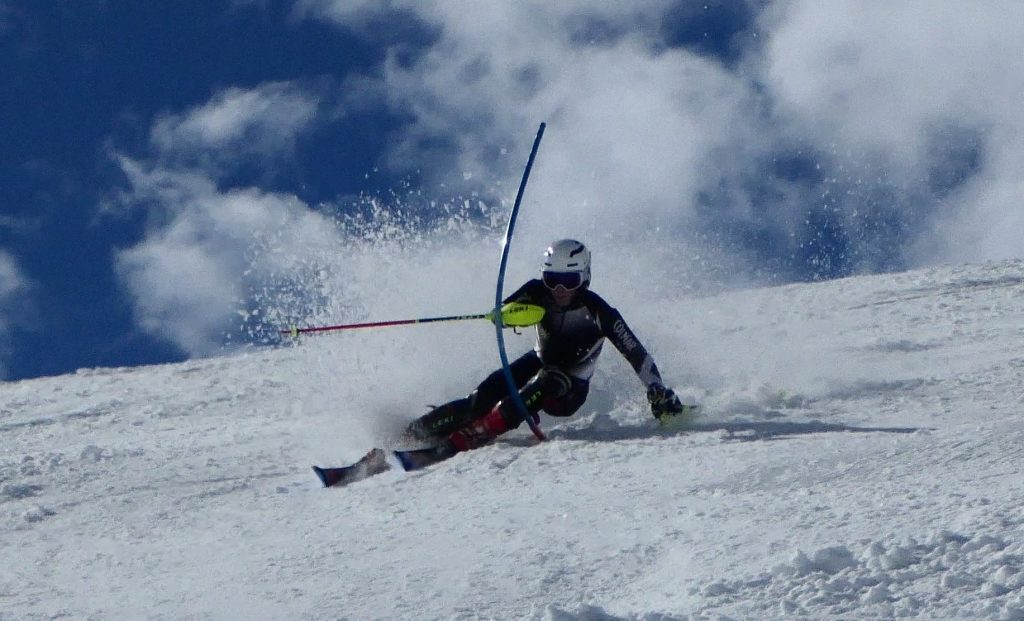- Combining Dynamics and Pivot
- Feet – Spiral Dynamics and Ankle Flex
- Introduction to Carving
- Sideslip
- Pivot
- Compression Turns
Combining Dynamics and Pivot
- Dynamics depends of forward motion of the skis and lateral falling/pushing of the centre of mass
- Pivot depends on lateral motion of the skis – but always with the centre of mass being driven inward (toward the turn centre) modulated by the support of a pole plant
- The two can be combined – when there is both forward and lateral motion – making overall control of trajectory and speed totally under control of the skier
- In all cases there must be active adductor muscle use – and the feet must be “everted” i.e. turned outward inside the ski boots – diverging sightly (skating stance)
- The essential element to take from combining pivot and dynamics is to execute the turn transition from the uphill edge of the uphill ski – noting that the ski enters the new turn more easily than when on its inside edge and this also prevents stemming (and body rotation)
- Additionally with the transition between the two turns being made from the uphill edge it’s easy to switch into a very tight pivot when desired
Look at the skis in the two images below. The top image is with skis carving – the bottom image skis pivoting


Feet – Spiral Dynamics and Ankle Flex
For dealing with feet pain make sure you aren’t scrunching your toes up and replace this act of tension by lifting the toes up and holding them up.
To avoid pronation of the foot and apparent “flat arches” it suffices to activate the muscles across the main body of the foot in the following manner…
- place the foot on the ground on its outside edge (supinated at the subtalar joint)
- holding the foot on its outside edge stretch the ball of the foot toward the floor
- this takes practice to increase the range of movement available
- when stretched as much a possible – while maintaining the stretch lower the ball of the foot to the ground
- maintain the muscles active to constantly prevent pronation and maintain an active arch
- you can keep pressure on the outside edge of the foot and the ball of the foot – while it’s the adductor muscles pulling inwards that holds the ski on its inside edge
Completing a short turn if you allow the downhill foot to roll onto its outside edge (even though the ski is hard on its inside edge) this frees up the hip joint making angulation much easier!
It’s not the feet that hold the ski on edge it’s the angle of the entire lower leg – controlled by angulation, inclination and the overall motion of the centre of mass. Those who swear by using the knees to edge are looking forward to early knee replacement surgery.
Moguls/Bumps (Compression Turns)
Here’s a useful video showing proper compression turns at an advanced level. (Warning! – The drills used to “teach” in the clip are mainly inappropriate and fail to show the pivoting nature of bump skiing. However the advanced dynamics used by the demonstrators are correct.)
Competition bumps skiers have their feet close together and many people swear by a “two footed” platform off-piste. This works because both skis pivot always on their uphill edge. The feet are always kept downhill of the body and so are the knees. Using the adductor muscles of both legs pulls the skis together and strengthens the stance. It’s important however to always orient the body on only one hip – preferably the outside one. The hip is the biggest joint in the body and it is very close to the centre of mass. Any confusion around this area leads to confusion everywhere. Motion starts from the centre of mass – so use your outside hip in the turn – pulling it backwards during the turn – to get your reflexes working and your core muscles protecting your back the most efficiently possible.
For bumps the two ski pivot prevents the feet from diverging off in different directions – and it gives two edges for controlling speed in what is after-all a braking form of turning. The overall stance is similar to off-piste but is part of a “compression turn” which has it’s own page here for reference (or soon will have). Avoid resorting to pushing out the heels – it’s always a pulling inwards that’s required.

